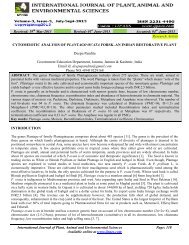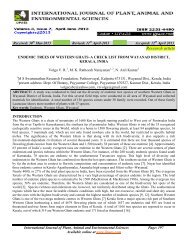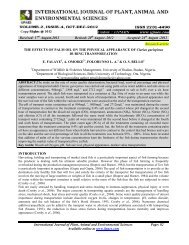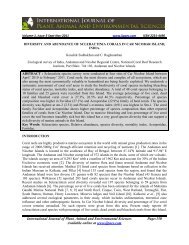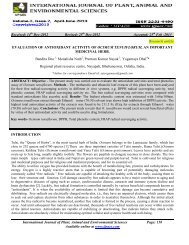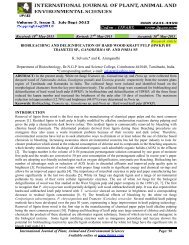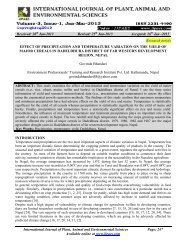pseudodendrothrips mori - Ijpaes.com
pseudodendrothrips mori - Ijpaes.com
pseudodendrothrips mori - Ijpaes.com
You also want an ePaper? Increase the reach of your titles
YUMPU automatically turns print PDFs into web optimized ePapers that Google loves.
Volume-1, Issue-3 Sept-Nov-2011 www.ijpaes.<strong>com</strong> ISSN 2231-4490<br />
INFLUENCE OF THRIPS (PSEUDODENDROTHRIPS MORI) INFESTATION ON THE<br />
BIOCHEMICAL CONSTITUENTS AND PHOTOSYNTHETIC PIGMENTS OF MULBERRY<br />
(MORUS SPP.) LEAVES<br />
A. MAHADEVA 1<br />
1<br />
Residential Coaching Academy, Babasaheb Bhimrao Ambedkar University,<br />
Vidya Vihar, Rae Barely Road, Lucknow – 226 025.<br />
1<br />
corresponding author : Phone -91 9844774389, +91 8960730795; Fax – 0522 2441888, 2440821 ; e-mail ;<br />
amdeva2007@gmail.<strong>com</strong><br />
ABSTRACT: The occurrence of fringed wings insect, Pseudodendrothrips <strong>mori</strong> is a major pest of mulberry, which<br />
causes a considerable leaf yield loss and inturn damages its quality. Hence, an attempt was made to know the<br />
changes in biochemical constituents (Free amino acids, total soluble proteins, total reducing sugars, total soluble<br />
sugars, starch and total phenols) and photosynthetic pigments (total chlorophyll, chlorophyll – a, chlorophyll – b,<br />
chlorophyll – a/b ratio and carotenoids) in thrips infested mulberry foliage of six popular varieties (M 5 , MR 2 , Mysore<br />
local, S 36 , S 54 and V 1 ). It was found that there was a significant variation in biochemical constituents and<br />
photosynthetic pigments in the thrips infested mulberry leaves <strong>com</strong>pare to healthy. These post-infestational changes<br />
in these <strong>com</strong>ponents leads to imbalance in nutritional status of mulberry leaves which adversely influence the growth<br />
and development of silkworm as well as quality of silk produced.<br />
Key words: biochemical constituents, infestation, mulberry, photosynthetic pigments, pest, thrips<br />
INTRODUCTION<br />
Mulberry (Morus spp.) is a perennial, deep rooted, fast growing and high biomass producing foliage plant. It forms<br />
the basic food material for the silkworm, Bombyx <strong>mori</strong> L. Increased production of raw silk, to large extent, depends<br />
on timely supply of quality mulberry leaves to silkworms. It is therefore clear that mulberry leaf plays a dominant<br />
role in cocoon production as a source of nutrition to the silkworm. The quality of mulberry leaf is influenced by<br />
several factors such as variety, agronomic practices, biotic and abiotic <strong>com</strong>ponents (Krishnaswami et al. 1970). Inspite<br />
of adopting all these, sometimes, the nutritive values are degraded due to diseases and pest damage. Insect pests<br />
take a heavy toll of mulberry. Thrips (Pseudodendrothrips <strong>mori</strong> Niwa) are one of the important sap sucking insect<br />
pests of mulberry, belonging to the order Thysanoptera : Tripiidae. The estimated leaf loss due to this pest is about 40<br />
– 50 % of the total leaf produced. Thrips causes a damage on a single leaf blade by using their mouth parts, rasp the<br />
epidermis on the ventral side. During laceration, they secret saliva, which coagulates the sap resulting in the<br />
formation of white streaks in the early stage followed by salivary blotches (Hadimani et al. 2006). The usual<br />
transpiration process of leaves is quickened through these wounds especially during high temperature seasons.<br />
Finally the leaves are dwindled and dried just like a piece of paper, being unfit to be used as feed to silkworms (Ye<br />
and Gu, 1990). An attempt was made to know the influence of thrips infestation on the biochemical <strong>com</strong>ponents and<br />
photosynthetic pigments of mulberry leaves.<br />
MATERIALS AND METHODS<br />
Six popularly cultivated indigenous mulberry varieties (M 5 , MR 2 , Mysore local, S 36 , S 54 and V 1 ) were chosen. The<br />
healthy and thrips-infested (Pseudodendrothrips <strong>mori</strong> Niwa) leaves were collected from mulberry gardens situated in<br />
and around Bangalore rural (Kanakapura and Ramanagaram taluk) and Tumkur district (Karnataka State), India. The<br />
leaves were oven - dried and processed to analyze the free amino acids by Ninhydrin method (Moore and Stein,<br />
1948) and total soluble proteins (Lowry et al. 1951) The reducing sugars were estimated by using DNS (Dinitrosalysilic<br />
acid) method (Miller, 1972).<br />
International Journal of Plant, Animal and Environmental Sciences Page: 57<br />
Available online at www.ijpaes.<strong>com</strong>
Mahadeva IJPAES ISSN 2231- 4490<br />
While the soluble sugars and starch contents were determined by anthrone method (Yemm and Willies, 1954). Folinciocalteau<br />
was used to determine the total phenols (Bray and Thorpe, 1954). The photosynthetic pigments viz.,<br />
chlorophyll (total chlorophyll, chlorophyll – a, chlorophyll – b and chlorophyll – a/b ratio) and carotenoids were<br />
estimated in fresh leaves by following Arnon’s (1949), Mahadevan and Sridhar’s (1984) procedures respectively.<br />
The results were analysed statistically by applying Student’s t-test.<br />
RESULTS AND DISCUSSION<br />
BIOCHEMICAL COMPONENTS (Table – 1)<br />
Table – 1: Biochemical changes (dry weight) in the thrips infested mulberry leaves.<br />
** Significant at 1% level; * Significant at 5% level ; Values in parenthesis indicate difference over healthy (+ = more than; - less than; --- No changes/<br />
alteration).<br />
It is an established fact that the biochemical constituents and photosynthetic pigments of mulberry leaves play a<br />
major role in the improved production of silk. They were changed drastically due to thrips – infestation in all the<br />
mulberry varieties considered.<br />
Free amino acids<br />
The free amino acids were increased significantly in thrips infested leaves of M 5 and S 36 (4.00 %) and nonsignificantly<br />
in the leaves of MR 2 (58.33 %) variety. The thrips infested leaves having a significant decreased free<br />
amino acid contents in the leaves of Mysore local, S 54 and V 1 . The decrease was minimum in S 54 (8.33 %) and<br />
maximum (37.39%) in the leaves of Mysore local variety.<br />
The amino acid content was increased (Kurangi, Thysong-3, Vietnam and Thailand) as well as decreased (M 5 , Kajali,<br />
Hakkikalu and M. nigra) in the leaves of mulberry varieties due to thrips attack (Latha, 1999). The silkworm, B. <strong>mori</strong><br />
requires 10 essential amino acids which can be synthesised by silkworm only when their precursors are present in its<br />
diet i.e., mulberry leaves (Bajpeyi et al. 1991). Variation in the free amino acid level in mulberry leaves due to thrips<br />
infestation may alter its requirement for the silkworm growth and development. This leads poor biosynthesis of silk.<br />
Total soluble proteins<br />
The P. <strong>mori</strong> infested leaves showing significantly decreased total soluble proteins in the leaves of M 5 , Mysore local<br />
and S 54. But, the decrease was non-significant in leaves of MR 2 (1.90%) variety. The reduction was maximum<br />
(31.39%) in the leaves of Mysore local. The increased total soluble proteins were observed in the leaves of S 36 (0.89<br />
%) and it was significant in V 1 (22.50%) variety.<br />
The protein content was increased in the leaves of M 5 , Kurangi, Kajali, Vietnam, Thailand and M. nigra and<br />
decreased in Hakkikalu and Thysong-3 due to thrips infestation (Latha, 1999). The decrease in the protein content<br />
may be attributed to the damage caused by the insect through sucking of the leaf sap; thus altering the metabolic<br />
functions leading to either decline in protein synthesize or mobilization of the proteins for repair of the damaged<br />
tissues in order to develop resistance to insect bite (Sathya Prasad et al. 2002). Reduction in the protein content of<br />
infested leaves may be partly due to utilization by the insect pest at a faster rate for its multiplication. Hydrolysis of<br />
proteins by proteolytic enzymes secreted by the pest itself, may be the other cause for lowering of proteins (Sengupta<br />
et al. 1990). Increase in the protein content may be a result of possible change in its synthesis pattern to over<strong>com</strong>e the<br />
injury and develop resistance (Satya Prasad et al. 2002).<br />
International Journal of Plant, Animal and Environmental Sciences Page: 58<br />
Available online at www.ijpaes.<strong>com</strong>
Mahadeva IJPAES ISSN 2231- 4490<br />
Total reducing sugars<br />
The total reducing sugars were declined significantly in the leaves of M 5 , Mysore local, S 36 and S 54 and nonsignificantly<br />
in the leaves of MR 2 variety due to thrips infestation. The thrips infested leaves of MR 2 and S 54<br />
respectively showed a lower (9.23 %) and higher (31.68 %) percentage of decrease in the total reducing sugars. The<br />
increased total reducing sugars were noticed in the leaves of V 1 (130.38 %).<br />
Latha (1999) noticed the increased reducing sugar content in the thrips infested leaves of four indigenous (M 5 ,<br />
Kurangi, Kajali and Hakkikalu) and four exotic (Thysong-3, Vietnam, Thailand and M. nigra) mulberry varieties.<br />
The reducing sugars are required for the biosynthesis of fibroin and sericin by the silkworm along with amino acids<br />
(Dorcus and Vivekanandan, 1997). Alteration in the reducing sugars may be due to reduction in leaf lamina and<br />
malformation of leaves in pest affected plants resulting in less productivity (Shree and Umesh Kumar, 1989).<br />
Total soluble sugars<br />
Total soluble sugars were decreased in the thrips infested leaves of M 5 , MR 2 , Mysore local, S 36 and V 1 . The decrease<br />
was maximum (18.00%) in the leaves of M 5 and minimum (11.46 %) in MR 2 variety. In S 54 variety, the total soluble<br />
sugars were not varied even after P. <strong>mori</strong> infestation. Latha (1999) observed the increased soluble sugar content in<br />
M 5 , Kurangi, Hakkikalu, Thysong-3, Vietnam, Thailand and M. nigra and decreased in the Kajali mulberry variety<br />
due to thrips.<br />
Starch<br />
The starch content was lowered in the leaves of MR 2 (7.87 %) and increased in the leaves of M 5 , Mysore local, S 36<br />
and V 1 in the thrips infested mulberry leaves. The leaves of S 54 variety showed a no-alteration in the starch content<br />
even after thrips attack. The thrips infested leaves of S 36 variety showed lower (2.04 %) and higher in the leaves of V 1<br />
(5.41 %) variety.<br />
Suma (2001) noticed the decreased enzymes activity (protease and amylase) and their substrate levels (proteins and<br />
starch) in thrips infested leaves of eight indigenous (C 6 , Hakkikalu, M 5 , Mysore local, S 30 , S 36 , S 41 and S 54 ) and four<br />
exotic (Kosen, KNG, Tsukasaguwa and Vietnam) mulberry varieties.<br />
Total phenols<br />
The total phenolic contents were decreased in the thrips infested leaves of M 5, MR 2 (16.53%) and S 54 (10.53 %). The<br />
increase was maximum (11.54 %) and minimum (2.99%) in the leaves of Mysore local and V 1 varieties respectively.<br />
The total phenols were not altered in the leaves of S 36 variety due to pest injury.<br />
The phenolic content was increased significantly in thrips infested leaves of M 5 , Hakkikalu and M. nigra and<br />
decreased in Kurangi, Kajali, Thysong-3, Vietnam and Thailand varieties. The accumulation of phenolics in the host<br />
may inactivate the enzyme which inhibits the further advance of the pathogenic organism by limiting its source of<br />
nutrients (Uritani, 1961). The most important phenolic <strong>com</strong>pounds implicated in defence mechanism of plants<br />
against pathogens are coumaric acid, phloretin, umbelliferous, caffeic acid, chlorogenic acid and ferulic acid (Agrios,<br />
1969). Hadimani et al. (2006) reported early maturity, depletion of moisture and reduction in foliar constituent (crude<br />
protein, total sugars and carbohydrates etc.,) in the thrips infested mulberry leaves. Alterations in the biochemical<br />
constituents were observed in other cases also, where mulberry leaves were infested by various pests - such - as<br />
jassids (Shree and Mahadeva, 2005 a), leaf roller (Narayanaswamy, 2003), mealy bugs (Shree and Umesh Kumar,<br />
1989: Veeranna, 1997) and thrips (Sengupta et al. 1990; Satya Prasad et al. 2002). This alteration in the biochemical<br />
<strong>com</strong>position may be because of disturbed host metabolism due to pest damage (Umesh Kumar et al. 1990). The<br />
altered biochemical constituent leads to imbalance in the nutritional <strong>com</strong>ponents of mulberry foliage which when fed<br />
to silkworms exert a harmful affect on their growth and development.<br />
The chlorophylls are the essential catalysts of photosynthesis and occur universally as green pigments in all the<br />
autotrophic plant tissues. In the present work, drastic changes were noticed in the photosynthetic pigments of all the<br />
mulberry varieties considered due to thrips - attack.<br />
The total chlorophyll contents were decreased significantly in the thrips infested mulberry leaves of six varieties. The<br />
reduction was maximum (57.01 %) in Mysore local and minimum (20.20 %) in the leaves of S 36 variety.<br />
The thrips infested leaves of all the maturity levels in six mulberry varieties the chlorophyll – a content decreased<br />
significantly. The reduction was in the range of 22.62 % to 56.83 % in the leaves of S 36 and Mysore local varieties<br />
respectively.<br />
International Journal of Plant, Animal and Environmental Sciences Page: 59<br />
Available online at www.ijpaes.<strong>com</strong>
Mahadeva IJPAES ISSN 2231- 4490<br />
PHOTOSYNTHETIC PIGMENTS (Table - 2)<br />
Table – 2 : Changes in the photosynthetic pigments (mg/g. fresh weight) of thrips infested mulberry leaves.<br />
* Significant at 1% level; * Significant at 5% level; Values parenthesis indicate difference over healthy (+ = more than; - less than).<br />
The chlorophyll – b contents were decreased significantly in the leaves of all the six varieties due to thrips<br />
infestation. The reduction was in the range of 9.81 % to 57.95 % in leaves of S 36 and Mysore local varieties<br />
respectively.<br />
The chlorophyll – a/b ratio reduced in the leaves of MR 2 , S 36 and S 54 due to thrips infestation. The reduction was low<br />
(5.53 %) in MR 2 and higher (29.29%) in the leaves of S 54 variety. The thrips infested leaves of M 5 , Mysore local and<br />
V 1 varieties showed an increased chlorophyll – a/b ratio. However, it was significant only in leaves of M 5 variety.<br />
The leaves of M 5 and Mysore local varieties showed a maximum (39.57%) and minimum (2.62%) increase of<br />
chlorophyll – a/b ratio respectively.<br />
The carotenoids were decreased significantly in all the leaves of six mulberry varieties due to thrips infestation. The<br />
reductions of carotenoids were maximum (59.59%) in Mysore local and minimum (17.27%) in the leaves of S 36<br />
mulberry variety.<br />
Das et al., (1994) observed a <strong>com</strong>bined loss of total chlorophyll and carotenoids (57.44 and 52.07 % respectively) in<br />
the thrips - infested mulberry leaves. Satya Prasad et al. (2002) observed a non-significant change in the total<br />
chlorophyll, chlorophyll – a, chlorophyll – b and carotenoids in K 2 , S 13 , S 34 , S 36 and V 1 mulberry varieties due to<br />
thrips - infestation. Decrease in chlorophyll and carotenoid contents in infested leaves may have been due to loss in<br />
chlorophyll synthetase activity in response to thrips infestation (Das et al., 1994).<br />
Etebari and Bizhannia (2006) observed that there was a significant decrease in total cocoon production, cocoon<br />
weight, pupal weight, and shell weight due to feeding of thrips infested leaves.<br />
Thus, the content of photosynthetic pigments varied depending upon the pest, intensity of pest-infestation, extent of<br />
damage and mulberry varieties. The reduction in the photosynthetic pigment(s) and/or laminar area caused due to<br />
feeding nature of insect pests will result in decreased photosynthetic efficiency and thereby the productivity.<br />
Sengupta et al. (1999) observed a significant difference in the photosynthetic rate between the healthy and thrips -<br />
infested leaf as well as in different positions of the diseased leaves. As a result, mulberry leaves suffer from<br />
nutritional inferiority. Similar observations were made in other cases when mulberry leaves were infested by various<br />
pests such as mealy bugs (Shree and Umesh Kumar, 1989), jassids (Shree and Mahadeva, 2005 a), spiralling whitefly<br />
(Narayanaswamy et al. 1999; Chandramohan et al. 2001) and leaf rollers (Narayanaswamy, 2003; Mahadeva and<br />
Shree, 2005).<br />
Most sap sucking insects, such as adult leaf hoppers, aphids, or thrips cause minimal direct tissue destruction. These<br />
insects use a specialized mouth part, the stylet, to locate, penetrate and drain sap from the phloem sieve elements of<br />
the plants vascular tissue. Heavy infestation caused by them leads to chronic shortages of photosynthates and thus<br />
severely reduce the growth potential of the plant (Kim Hammond-Kosack and Jonathan Jones, 2000).<br />
International Journal of Plant, Animal and Environmental Sciences<br />
Available online at www.ijpaes.<strong>com</strong><br />
Page:60
Mahadeva IJPAES ISSN 2231- 4490<br />
The altered chlorophyll content adversely affected the photosynthetic activity (Heldt, 1997), productivity which<br />
ultimately leads to reduced protein synthesis (Burd and Elliot, 1996). Consequently, the nutritional status of mulberry<br />
foliage <strong>com</strong>es down (Shree and Umesh Kumar, 1989). Therefore, the pest - attacked leaves when fed to silkworms<br />
will exert an adverse impact on their growth and development, leading to cocoon crop failures (Pradeep Kumar et al.<br />
1992; Doureswamy and Chandramohan, 1999; Shree and Mahadeva, 2005 b; Muthuswami et al. 2010). The pest -<br />
injured mulberry leaves should not be used for silkworm feeding as they are known to affect the <strong>com</strong>mercial<br />
characters of cocoons (Mahadeva and Shree, 2004).<br />
REFERENCES<br />
Agrios, G.N (1969). Plant Pathology. Ed. G.N. Agrios, Academy Press. New York. pp. 93-112.<br />
Arnon, D.J (1949). Copper enzymes in isolated chloroplasts. Polyphenol-oxidase in Beta vulgaris. Plant Physiol. 24:<br />
1-15.<br />
Bajpeyi, C.M., Singh, R.N and Thangavelu, K (1991). Supplementary nutrients to increase silk production. Indian<br />
Silk. 30(7): 41-42.<br />
Bray, H.G and Thorpe, W.V (1954). Analysis of phenolic <strong>com</strong>pounds of interest in metabolism. Meth. Biochem.<br />
Anal. 1: 27-52.<br />
Burd, J.D and Elliot, N.C (1996). Changes in chlorophyll - a flourescence induction kinetics in cereals infested with<br />
Russian wheat aphid (Homoptera: Aphididae). J. Econ. Entomol. 89: 1332-1337.<br />
Chandramohan, N., Baskar, P and Palanidorai, S (2001). Histological changes associated with feeding of<br />
Maconellicoccus hirsutus (G) and Aonidiella aurantii (M) in mulberry. National Seminar on “Emerging<br />
Trends in Pests and Diseases and their Management”, 11 th to 13 th October, Tamil Nadu Agricultural<br />
University. Coimbatore. pp. 197.<br />
Das, C., Shivanath and Rao, K.M (1994). An investigation of morpho-physiological changes due to thrips infestation<br />
in mulberry (Morus alba L.). Geobios. 21(2):109-113.<br />
Dorcus, D and Vivekanandan, M (1997). Exploitation of mulberry genotypes for drought tolerance potential. J. Seric.<br />
Sci. Jpn, 66(2): 71-80.<br />
Doureswamy, S and Chandramohan, N (1999). Investigation on the economic characters of silkworm Bombyx <strong>mori</strong><br />
L. as influenced by the spiralling whitefly damage on mulberry. Abstract of National Seminar on “Tropical<br />
Sericulture”. 28 th to 30 th December, University of Agricultural Sciences, Bangalore – 560 065. pp. 82.<br />
Etebari, K and Bizhannia, A.R (2006). Effects of thrips (Pseudodendrothrips <strong>mori</strong> Niwa) infested mulberry leaves<br />
on silkworm growth and <strong>com</strong>mercial cocoon parameters. Caspian J. Env. Sci. 4(1):31-37<br />
Hadimani, D.K., Amarnath, N., Manjula, G and Narayanaswamy, K.C (2006). Management of mulberry thrips.<br />
Indian Silk. 44(12): 11-12.<br />
Heldt, H.W (1997). The use of energy from sunlight by photosynthesis. In plant Biochemistry and Molecular<br />
Biology. Institute of Plant Biochemistry, Oxford University Press. New York. pp. 39-59.<br />
Kim Hammond-Kosack and Jonathan D.C. Jones (2000) Responses to Plant Pathogens. Biochemistry and Molecular<br />
Biology of Plants. (Eds; Buchanan, B., Gruissem, W. and Jones, R.) American Society of Plant Physiology.<br />
pp. 1102-1155.<br />
Krishnaswami, S., Noamani, M.K.R and Ahsan, M (1970). Studies on the quality of mulberry leaves and silkworm<br />
crop production, Part-I, quality differences due to varieties. Indian J. Seric., 9(1): 1-10.<br />
Latha, M.K (1999). Biochemical analysis of thrips infested leaves of different mulberry varieties. M.Sc., (Seric.,)<br />
Dissertation, Bangalore University, Bangalore – 560 056. pp. 12-16.<br />
International Journal of Plant, Animal and Environmental Sciences Page: 61<br />
Available online at www.ijpaes.<strong>com</strong>
Mahadeva IJPAES ISSN 2231- 4490<br />
Lowry, O.H., Rosebrough, N.J., Fan, A.L and Randall, R.J (1951). Protein measurement with Folin-phenol reagent.<br />
J. Boil. Chem., 193: 265-275.<br />
Mahadeva, A and Shree, M.P (2003). Effect of feeding spiralling whitefly (Aleurodicus dispersus Russell) infested<br />
mulberry leaves on the nutritional efficiency and economic parameters of silkworm (Bombyx <strong>mori</strong> L.)<br />
National Seminar on “Disease and Pest Management of Sericulture”, 12 th and 13 th September. Sericulture<br />
College, University of Agricultural Sciences, Chintamani, Kolar District. Abstract No. 3. pp. 3.<br />
Mahadeva, A and Shree, M.P (2004). Impact of feeding mealy bugs (Maconellicoccus hirsutus Green) infested<br />
mulberry (Morus alba L.) leaves (tukra) on the nutritional efficiency and economic characters of silkworm<br />
(Bombyx <strong>mori</strong> L.). 91 st Indian Science Congres, 3 rd to 7 th January, Chandigarh. Adv. Abst. XIV. pp. 22-23.<br />
Mahadeva, A and Shree, M.P (2005). Alterations in the biochemical <strong>com</strong>ponents and photosynthetic pigments of<br />
mulberry (Morus sp.) attacked by pyralid leaf roller - Diaphania pulverulentalis moth. VII National<br />
Seminar on “Indian Entomology: Productivity and Health” (A Silver Jubilee Celebration), 2 nd to 4 th<br />
October, Gurukula Kangri University, Haridwar. The Uttar Pradesh Zoological Society, Muzaffarnagar,<br />
Uttar Pradesh. pp. 44.<br />
Mahadevan, A and Sridhar, R. (1984). Methods in Physiological Plant Pathology. Shivakami Publications, Madras.<br />
pp. 5-11.<br />
Moore, S and Stein, W.H (1948). Photometric method for use in chromatography of amino acid. J. Biol. Chem. 176:<br />
367-388.<br />
Miller, G.L (1972) Use of dinitro-salicylic acid reagent for determination of reducing sugars. Anal. Chem., 31: 426-<br />
428.<br />
Muthuswami, M., Subramanian, S., Krishnan, R., Thangamalar, A and Indumathi, P (2010). Quantitative and<br />
qualitative damage caused in mulberry varieties due to infestation of thrips Pseudodentrothrips <strong>mori</strong> Niwa.<br />
Karnataka J. Agric. Sci. 23(1):146-148.<br />
Narayanaswamy, K.C (2003). Biochemical <strong>com</strong>position of leaf roller infested mulberry leaf. Insect Environment.<br />
8(4): 166-167.<br />
Narayanaswamy, K.C., Ramegowda, T., Raghuraman, R and Manjunath, M.S (1999). Biochemical changes in<br />
spiralling whitefly (Aleurodicus dispersus Russell) infested mulberry leaf and their influence on some<br />
economic parameters of silkworm (Bombyx <strong>mori</strong> L.). Entomon. 24(3): 215-220.<br />
Pradeep Kumar., Kishore, R., Noamani, M.K.R and Sengupta, K (1992). Effect of feeding tukra affected mulberry<br />
leaves on silkworm rearing Organisation. Agricultural Services Bulletin. United Nations Organisation,<br />
Rome. pp. 1-97.<br />
Satya Prasad, K., Sreedhar, S., Singhvi, N.R., Kodandaramaiah, J and Sen, A.K (2002). Post - thrips infestation<br />
biochemical changes in leaves of mulberry (Morus spp.). Plant Archives. 2(1): 85-88.<br />
Sengupta, K., Kumar, P., Baig, M and Govindaiah (1990) Handbook of Pest and Disease Control of Mulberry and<br />
Silkworms. Economic and Social Commission for Asia and Pacific. Thailand. p. 88.<br />
Sengupta, K., Misra, A.K., Das, C., Das, K.K., Sen, S.K and Saratchandra, B (1999). Physiobiochemical changes in<br />
thrips infested mulberry leaves. Sericologia. 39(3): 417-421.<br />
Shree, M.P and Mahadeva, A (2005 a). Impact of jassids (Empoasca flavescens F.) infestation on the biochemical<br />
constituents and photosynthetic pigments of mulberry (Morus spp.) foliage. National Seminar on “Scenario<br />
of Sericulture in India”, 25 th and 26 th March, Sri Padmavathi Mahila Visvavidyalayam, Thirupathi, Andhra<br />
Pradesh. pp. 13.<br />
International Journal of Plant, Animal and Environmental Sciences Page: 62<br />
Available online at www.ijpaes.<strong>com</strong>
Mahadeva IJPAES ISSN 2231- 4490<br />
Shree, M.P and Mahadeva, A (2005 b). Biochemical studies in the pest - infested mulberry varieties and their impact<br />
on sericulture. VII National Seminar on “Indian Entomology: Productivity and Health” (Silver Jubilee<br />
Celebration), 2 nd to 4 th October, Gurukula Kangri University, Haridwar. The Uttar Pradesh Zoological<br />
Society, Muzaffarnagar, Uttar Pradesh. pp. 173-186.<br />
Shree, M.P and Umesh Kumar, N.N (1989). Biochemical changes in tukra affected exotic mulberry plant. Curr. Sci.<br />
58(22): 1251-1253.<br />
Suma, R (2001). Enzymatic studies in the thrips infested mulberry leaves, M.Sc., (Seric.,) Dissertation, Bangalore<br />
University, Bangalore – 560 056.<br />
Umesh Kumar, N.N., Shree, M.P., Muthegowda and Boraiah, G (1990). Changes in proteins, sugars, phenols and<br />
total chlorophyll content of mulberry plants affected by “tukra”. Indian J. Seric. 29(1): 93-100.<br />
Uritani, I (1961). Changes in phenolic <strong>com</strong>pounds in rice varieties as influenced by Xanthomonos oryzae infection. II<br />
Riso., 25: 55-89.<br />
Veeranna, G (1997). Biochemical changes in tukra leaves of mulberry and its effects on economic characters of<br />
mulberry silkworm, Bombyx <strong>mori</strong> L. Entomon. 22(2): 129-133.<br />
Ye, Y-B and Gu, Z-F (1990). Chemical control of the mulberry thrips, Pseudodendrothirps <strong>mori</strong> (Niwa).<br />
Sericologia. 30(3): 385-388.<br />
Yemm, E.W and Willis, A.J (1954). The estimation of carbohydrates in plant extracts by anthrone. Biochemical J.<br />
57: 508-514.<br />
International Journal of Plant, Animal and Environmental Sciences Page: 63<br />
Available online at www.ijpaes.<strong>com</strong>



